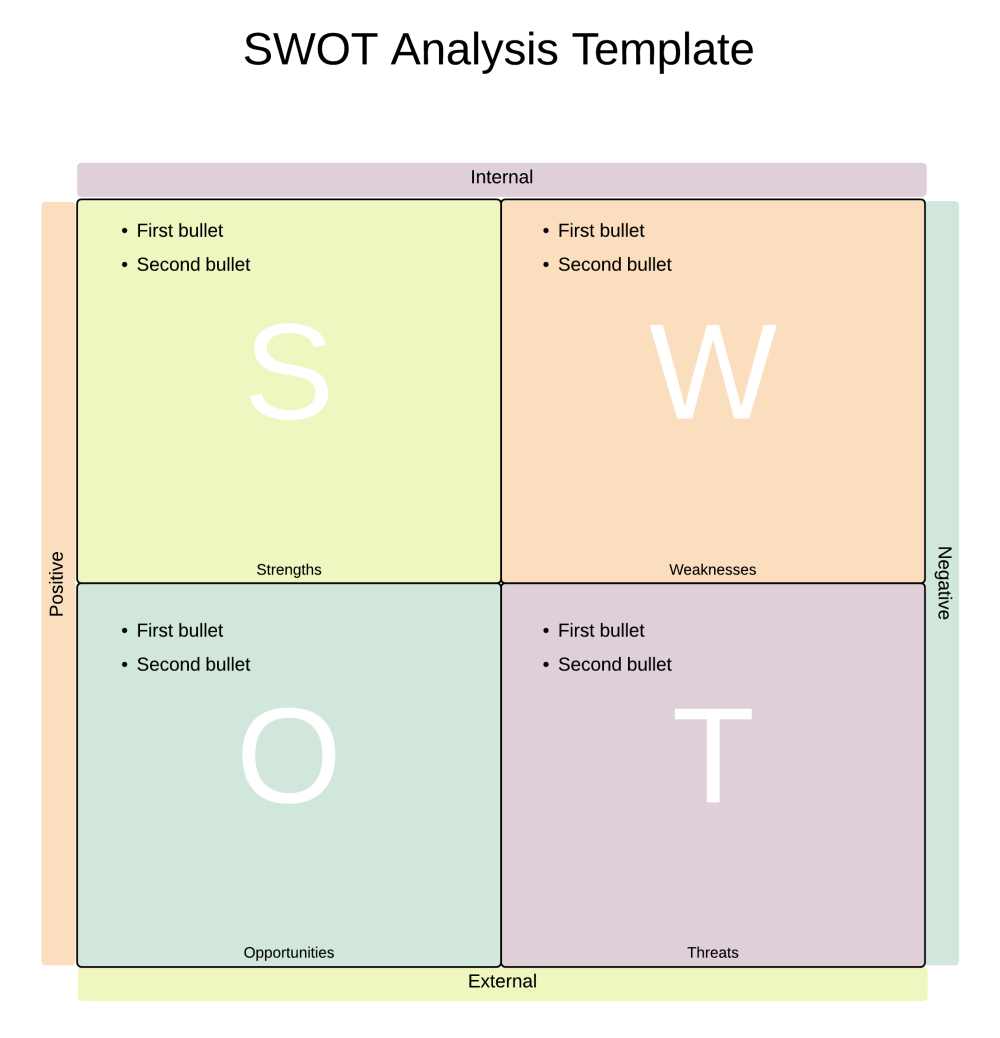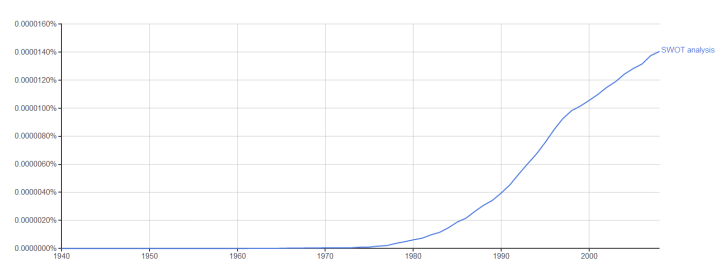What is a SWOT Analysis
A SWOT analysis is a type of diagram widely used in business and education used for exploring strengths, weaknesses, opportunities, and threats in a given situation.
A SWOT analysis is a visual study tool that can be used to identify specific strengths and weaknesses in work and personal life situations. It helps with decision making and planning ahead. A SWOT analysis diagram is formed by a two-by-two grid. Each quadrant has an outline of the subject's strengths, weaknesses, opportunities, and threats (SWOT).
Any business has strengths and weaknesses, but no organization exists in a vacuum--you must also analyze the opportunities and threats that abound in the marketplace. Our SWOT analysis tool keeps users informed about internal and external factors that affect their company's success. Lucidchart's SWOT tool utilizes a simple quadrant layout to quickly and efficiently chart and present key market findings.
A SWOT analysis is a simple way to discover positive and negative factors in any context. Specifically, it’s a 4-quadrant diagram that identifies strengths, weaknesses, opportunities, and threats. Creating a SWOT chart forces contributors to critically examine their circumstances and find out which obstacles must be overcome or minimized. A SWOT can also help determine steps that should be taken for short- and long-term success.
Getting Started in Lucidchart in Under 5 Minutes
- Create your first SWOT analysis from a template or blank canvas or import a document.
- Add text, shapes, and lines to customize your diagram.
- Learn how to adjust styling and formatting within your SWOT.
- Locate what you need with Feature Find.
- Share your SWOT analysis with your team to start collaborating.
When to use a SWOT analysis
SWOT analysis can be high-level or granular, and help the creator pinpoint both internal and external factors. This type of diagram becomes more useful when you take what you’ve learned and apply it in the real world. It is vital to have a clear question in mind when performing a SWOT analysis. By making the inquiry more specific, you will unearth weaknesses in a plan, budget, project, or goal you might not have otherwise. SWOT can be useful at the beginning of a project, or when your team has hit a roadblock.
These are some examples of when you could use SWOT to tackle a problem:
-
Expanding into a new market: Your business has found a large degree of success selling a product or service in your home country. Now you are looking to expand overseas. What strengths does this product bring to the table, and what drawbacks are there to this expansion? While the opportunities may look golden, the threats, in terms of new competitors or regulations, may not be obvious without in-depth scrutiny.
-
Website redesign: You’ve run the data to see where your site is succeeding, but do you know where you fail? Threats to your business can pop up daily in a fast-paced digital world—are you prepared to manage competition?
-
A new business idea: That bookstore or yoga studio you’ve wanted to open for ages may sound ideal now, but have you looked at the costs and benefits more concretely? Doing a SWOT analysis can organize your thoughts and make it more likely that you will succeed going forward.
-
Investment opportunity: Whether it’s buying shares in a company, buying new hardware for your firm, or even investing in your personal gadget collection, analysing the strengths and weakness of your potential acquisition can help prevent buyer’s remorse. Performing side-by-side SWOT diagrams for each investment you’re considering can help the right choice stand out.
-
Potential partnership: A SWOT analysis is a useful tool for examining personal compatibility. If you’re contemplating joining forces and going into business with a colleague, have you outlined factors that could threaten your business? Are you both on the same page about what opportunities there are in your market? Even romantic couplings can benefit from this process.
Applying to college or graduate programs: While the typical college entrance essay paints a rosy picture of the applicant, knowing your own weaknesses is important for academic success. A lower GPA could be boosted by excellent test scores, and fewer extracurricular activities can be explained by the need to support a family.
Tips for creating a SWOT analysis
SWOT diagrams tend to be straightforward, but the process of filling them out may not be so simple. To get the most out of your chart, follow these helpful tips:
-
Be realistic about the current state of your organization or problem. If you’re not sure whether something truly fits in its category, consult your team and leave the item off the list, if necessary.
-
Remember that SWOT analyses are meant to evaluate the present, not the past or the future. While the Opportunities quadrant lets you think about possibilities, be sure to ground every detail in fact.
-
Maintain the same level of specificity throughout the diagram. SWOT charts should be straightforward, so resist the urge to add too much detail. More information might be better suited to a report or presentation.
-
Use a SWOT analysis as a guide, rather than a rulebook. The details of any SWOT diagram can be debated endlessly; what’s important is getting your team on the same page and moving forward with purpose.
 Click to modify this SWOT analysis template
Click to modify this SWOT analysis templateHistory of SWOT analysis diagrams
SWOT analysis was invented in the 1960s by a management consultant named Albert Humphrey at the Stanford Research Institute. Previously, corporate planning had not met with much success. Fortune 500 companies needed a way to produce long-term planning that was executable and reasonable. Humphrey and his research team proposed the SWOT model to bring accountability and objectivity to the planning process, and it has been popular ever since.
Albert Humphrey advocated performing SWOT analysis on specific criteria, such as products, process, customers, distribution, finance, and administration. SWOT analysis has only grown in popularity since it was invented, as demonstrated by the Google Books Ngram search below.

How to fill out SWOT analysis quadrants
When you approach your quadrants, there are several questions you’ll want to consider. In many cases, it might be easier to begin with strengths and weaknesses, since internal characteristics are often easier to record. Consider factors like:
-
Experience: what do you know? Do you have a special understanding of your community, customers, or processes?
-
Financial status: is your bank account thriving or struggling? Do you have alternate sources of income?
-
Your human resources: employees, volunteers, leaders, mentors, or customers. How do they help or hurt you?
-
Tangible resources, like office location or hardware. What do you offer or lack?
Move on to opportunities and threats, which are external elements. In contrast to strengths, this category should focus on factors outside yourself or your business. A large budget is an opportunity, while good financial sense would be a strength. You should always try to be specific and realistic when considering opportunities. If you’re not sure what to add, consider factors like:
-
State of the economy—are your customers willing to buy? How does the local, national, or international economy affect your activities?
-
Current events, such as an uptick in crime or an upcoming festival. What impact do they have on your organization?
-
Demographics and psychographics—are there changes in your target audience’s age, race, gender, attitudes, values, or mindset?
How to make a SWOT analysis diagram in Lucidchart
Lucidchart is an online diagramming tool with several business and personal templates for SWOT diagrams. Starting with a SWOT analysis template lets you stop fiddling with menus and start planning.
-
Register for a Lucidchart account.
-
Navigate to My Documents.
-
Click Create > New Document, then choose Standard under Templates.
-
In All Categories, scroll down and select a SWOT Analysis template.
-
Edit the details of each quadrant by double-clicking and typing.
-
To alter text formatting, select a text box by clicking it. Then choose formatting options from the properties bar at the top of the editor.
-
To change color fill and other graphical properties, first select an object by clicking, or select multiple objects with Shift + click. Then choose from the options that appear in the properties bar or the graphic panel on the right side of the editor.
-
Click the Share tab for publishing options, or select File > Download to save the document to your desktop.
There are a variety of color schemes, preloaded bullet points, and the ability to share your diagram online or in print. These features all contribute to Lucidchart being the top choice for performing SWOT analysis.




